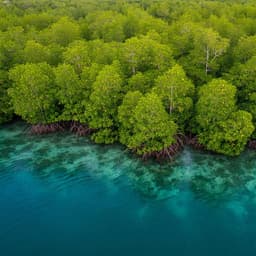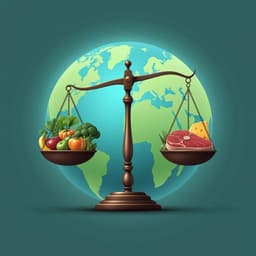
Environmental Studies and Forestry
Sustainably developing global blue carbon for climate change mitigation and economic benefits through international cooperation
C. Feng, G. Ye, et al.
This groundbreaking study evaluated the sustainable development of global blue carbon over 24 years using the innovative Blue Carbon Development Index (BCDI). Results indicate an encouraging upward trend in BCDI scores and propose a global cooperation model that could significantly enhance carbon sequestration and economic benefits. The research was conducted by Cuicui Feng, Guanqiong Ye, Jiangning Zeng, Jian Zeng, Qutu Jiang, Liuyue He, Yaowen Zhang, and Zhenci Xu.
~3 min • Beginner • English
Introduction
Blue carbon ecosystems—mangroves, salt marshes, and seagrasses—store carbon efficiently, representing about half of marine sediment carbon burial despite covering only a small fraction of ocean area. Global initiatives (e.g., Blue Carbon Initiative by IOC-UNESCO, IUCN, and CI) and policy milestones (e.g., the 2013 IPCC Wetlands Supplement) have elevated blue carbon as a nature-based climate solution. Estimates of global coastal wetland carbon stocks are substantial, and these ecosystems provide additional services such as pollution purification, coastal hazard mitigation, and nursery habitats. However, the sustainable development status of blue carbon at global and national scales is not well quantified, and the interplay among ecological resource endowments, climate-mitigation driving forces, and socioeconomic development capacity remains unclear. This study aims to fill these gaps by: (1) creating a Blue Carbon Development Index (BCDI) integrating driving force, resource endowment, and development capacity to assess long-term (1996–2019) sustainable development levels of blue carbon across 136 coastal countries; (2) exploring interrelationships among subsystems; and (3) proposing and testing an international cooperation model to enhance carbon sequestration and economic benefits. The work intends to guide conservation, restoration, and policy for sustainable coastal development and climate mitigation.
Literature Review
Prior research has emphasized biophysical aspects of blue carbon, including sinks, storage, and global stocks of coastal wetlands, alongside recognition of broader ecosystem services (e.g., storm and flood protection, pollution uptake, fisheries support, and recreation). Governance and socioeconomic aspects have also been explored, including strategies to minimize ecosystem losses, management frameworks, valuation of ecosystem services, and assessments of blue carbon wealth via social cost of carbon. International initiatives such as the Blue Carbon Initiative and regional partnerships (e.g., International Blue Carbon Partnership) reflect growing institutional interest. Nevertheless, a comprehensive, long-term, global assessment of the sustainable development level of blue carbon that integrates ecological resources, climate-driving forces, and socioeconomic development capacity has been missing. The paper situates its contribution within this gap, linking ecological endowment and socioeconomic governance capacity via an integrated index and cooperation modeling.
Methodology
Study scope and index framework: The authors identified 136 countries with distributions of mangroves, salt marshes, and seagrass based on global datasets. They designed the Blue Carbon Development Index (BCDI) comprising three subsystems: (1) Driving force (natural and anthropogenic drivers related to climate change mitigation, e.g., carbon emissions, population, climate risk/security); (2) Resource endowment (ecological status of blue carbon ecosystems, including distribution extent of mangroves, salt marshes, seagrasses; ecosystem health; carbon sequestration); (3) Development capacity (socioeconomic interventions supporting blue carbon development: governance, finance, technology, and marine protection and management). The indicator system contains 18 indicators (detailed in Supplementary Table S1).
Standardization and weighting: Indicators were standardized across all years and countries to a 0–100 scale. Positive indicators were normalized by (Xij − lower)/(upper − lower) × 100 and negative indicators by (upper − Xij)/(upper − lower) × 100, where upper and lower bounds were set at the 97.5th and 2.5th percentiles across all observations to reduce outlier influence. Indicator weights were derived via principal component analysis (PCA), performed on the weighted covariance matrix for all indicators across the three subsystems. PCA-based weights capture objective data variation and reduce collinearity. Subsystem weights equal the sum of their indicators’ weights. The BCDI score is the weighted sum of subsystem scores, with both subsystem and total scores ranging from 0 to 1 (later scaled for reporting). Annual global scores are country averages.
Linear mixed models and carbon estimation: To relate socioeconomic development capacity to ecological change, the authors used linear mixed models to predict the 4-year growth rate of blue carbon area as a function of development capacity (fixed effect), with country as a random effect. The selected model minimized AIC among alternatives. Predicted area growth rates were used to estimate carbon sequestration as Carbon = Area^(1+Rate − 4) × CRate, where Area is the base ecosystem area, Rate is the modeled growth rate over the previous four years, and CRate is the country-average carbon sequestration rate derived from ecosystem areas and burial rates.
Cooperation modeling and scenarios: Three scenarios were developed to assess future changes in BCDI and cooperation feasibility: (1) Business-as-Usual (BAU), projecting subsystem scores using Holt’s linear trend exponential smoothing; (2) Global Cooperation (GC); and (3) Global Deep Cooperation (GDC). GC and GDC build on BAU, assuming cooperation where countries with higher development capacity assist lower-performing countries. Cooperation intensities were mapped to achievable quantile states of indicators, following an approach adapted from Zhao et al., aiming to maximize global welfare. The authors evaluated country-level benefit allocation under cooperative carbon sequestration gains using cooperative game-theory methods (Equal Surplus Division, Equal Allocation of Non-Separable Costs, and Separable Cost Remaining Benefit), selecting the most appropriate for allocation fairness and stability.
Economic valuation: Economic benefits and costs under cooperation were assessed using country-level social cost of carbon (CSCC). Benefits equal CSCC multiplied by the difference between redistributed cooperative carbon and BAU; costs equal CSCC multiplied by the difference between within-country cooperative carbon and BAU.
Data sources: Carbon emissions (Global Carbon Atlas), energy structure (BP Statistical Review), climate risk (Germanwatch Climate Risk Index), population and GDP (World Bank), environmental science index (SCImago), governance (Corruption Perceptions Index), marine protected areas and their management effectiveness (Protected Planet), mangrove extent (Global Mangrove Watch), salt marsh and seagrass distributions (literature and UNEP-WCMC), ecosystem health (Halpern et al.), average carbon burial rates (literature), treaty participation (Kyoto Protocol, Paris Agreement), and carbon market status (International Carbon Action Partnership). Missing values were interpolated using nearby years.
Key Findings
- Global trend: The global BCDI score increased from 20.26 in 1996 to 32.55 in 2019, a 60.69% rise.
- Subsystems: Driving force increased by 23.86% over 24 years; development capacity rose markedly from 8.59 to 27.36; resource endowment declined slightly from 23.23 to 22.57 due to reduced ecosystem area and health deterioration.
- Ecosystem changes: Global mangrove area decreased by 87,695.07 ha between 2011 and 2013, coinciding with declines in ecosystem health. Only 23.53% of countries maintained or improved resource endowment scores from 1996 to 2019.
- Country performance: Strong gains were observed in many countries across the Americas, Asia, and Europe; Africa saw slight enhancements. The United States ranked highest in 2019, driven by high development capacity. Several countries (e.g., UK, Australia, Germany, Finland, Netherlands, France, Spain, Denmark, Sweden, Canada, Japan) also scored relatively high. Some countries (e.g., Angola, Haiti, Libya, Bosnia and Herzegovina, Somalia, Algeria, Bahrain) showed persistently low scores across subsystems.
- Regional differences: Europe and Northern America and Oceania outperformed other regions; five other UN-defined regions scored below the global average. A Kruskal-Wallis test indicated significant differences among regions (P < 0.001).
- Subsystem relationships: Development capacity shows a significantly positive correlation with resource endowment, suggesting governance, finance, technology, and protection can bolster ecosystem status.
- Cooperation scenarios: Under Global Deep Cooperation (GDC) in 2030 relative to BAU, the global average BCDI increases, annual carbon sequestration rises by 2.96 Mt, and global economic benefits reach $136.34 million (with corresponding cost of $82.79 million). The United States, Indonesia, and Malaysia can substantially enhance sequestration under GDC; Indonesia and Malaysia experience losses under BAU and GC but gains under GDC. The United States can provide support to others, adding 146.37 kt of sequestration in GDC vs. GC. Developed countries gain considerable benefits; their advantage in development capacity increases by 23.60% relative to GC.
Discussion
The study addresses the lack of a comprehensive, long-term global assessment of blue carbon sustainable development by integrating ecological, climatic, and socioeconomic dimensions into the BCDI. The observed global increase in BCDI, despite a modest decline in resource endowment, indicates that enhanced development capacity (governance, finance, technology, marine protection) can offset losses and improve sustainable development trajectories. The positive association between development capacity and resource endowment underscores the potential for policy and management interventions to stabilize and recover blue carbon ecosystems.
Regional disparities in BCDI reflect differences in economic strength, governance frameworks, protection coverage, and climate pressures. Asia, Latin America and the Caribbean, and Sub-Saharan Africa have strong resource endowments but lower development capacity and higher mitigation pressures, making them prime candidates to benefit from international cooperation. The proposed cooperation model demonstrates that coordinated action can increase carbon sequestration and generate net economic benefits, while also allowing developed countries to expand influence and accrue additional blue carbon benefits. Co-benefits include enhanced coastal protection, fisheries support, recreation, and broader contributions to SDGs, improving local resilience and livelihoods. Effective implementation requires clear objectives, integrated governance-finance-technology frameworks, and equitable benefit-sharing mechanisms, alongside public awareness and community participation.
Conclusion
This work introduces the Blue Carbon Development Index (BCDI), a comprehensive framework combining driving force, resource endowment, and development capacity to evaluate the sustainable development of blue carbon across 136 coastal countries from 1996 to 2019. The analysis reveals a global upward trend in BCDI, a strong role for development capacity, and significant regional disparities. A cooperation model and scenario analysis show that deep international cooperation can raise global BCDI, add approximately 2.96 Mt of annual carbon sequestration, and yield substantial economic benefits by 2030 compared to BAU.
The study provides a decision-support foundation for conservation, restoration, and policy design, demonstrating that strengthening governance, finance, technology, and marine protection can enhance ecological outcomes. Future research should extend BCDI to local scales with downscaled indicators (e.g., local projects, financial capacity, species composition), incorporate social dimensions of indigenous and community responses, and include additional ecosystem services (storm protection, habitat provision, pollution uptake) once consistent national and subnational datasets are available. Integrating blue carbon with other nature-based solutions and complementary measures (energy transitions, carbon markets, carbon capture and storage) will be essential for meeting climate goals.
Limitations
Uncertainties arise from reliance on heterogeneous global datasets, varying data quality, and the need to interpolate missing values using proximity methods. The indicator system focuses on carbon sink functions and excludes other ecosystem services due to limited globally consistent national data, potentially underrepresenting broader benefits. Model assumptions in the linear mixed models and cooperation scenarios may influence projections. Blue carbon is only one among multiple nature-based solutions; comprehensive climate mitigation requires integrating forests, peatlands, grasslands, energy system transformations, carbon markets, and carbon capture and storage.
Related Publications
Explore these studies to deepen your understanding of the subject.







